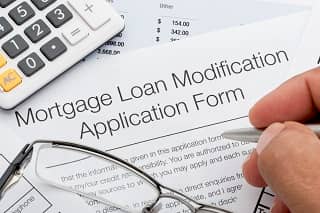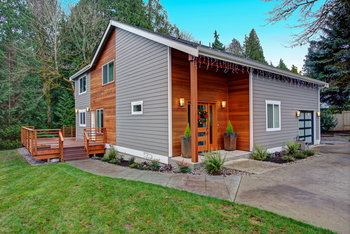
When mortgage rates drop, homeowners often wonder if they will be able to take advantage of lower interest rates. In general, lenders require borrowers to refinance into a new home loan in order to change their mortgage rate, requiring the borrower to requalify for a new mortgage, the house to pass an appraisal and the homeowner to again pay closing costs. However, there can be other avenues to explore if you don't want to refinance (or can't) but want to trade your higher interest rate for a lower one rate without refinancing: a loan modification or a loan "recasting".
Loan modifications for troubled homeowners
If you are having trouble keeping up with your monthly mortgage payments, you can apply for a loan modification to reduce your interest rate, extend your loan term, and hence, lower your monthly payment. A lender will review your current mortgage and financial situation before deciding to approve or deny you for a loan modification.
If you are having trouble paying your mortgage, you should contact your mortgage lender or servicer immediately to discuss your options and the possibility of a loan modification. You can find their number or their website address on your monthly bill or statement. Of course, you will be required to explain your hardship in writing and will likely need to provide documentation, including tax returns, pay stubs and other paperwork that reflects your income and assets.
Back in the last housing bust, when home values declined and many homeowners were struggling to make monthly mortgage payments, you may have heard of the Home Affordable Modification Program (HAMP), a national program intended to help preserve homeownership for troubled mortgage borrowers by modifying the terms of their mortgages to make them more affordable. This program expired years ago, but was replaced in 2017 by a new program run by Fannie Mae and Freddie Mac.
For conventional loans (usually conforming mortgages), the government's Flex Modification program has specific guidelines that must be met in order to participate. As was the case with HAMP, for these modifications, your loan must be owned or backed by Fannie Mae or Freddie Mac. To see if either holds your mortgage, use Fannie Mae's Loan Lookup Tool or Freddie Mac's Loan Lookup Tool to get started.
The Federal Housing Administration (FHA) also offers a number of programs to help troubled homeowners, including the FHA-HAMP program, where FHA allows for home loans to be modified to be more affordable. If you've got an FHA loan and are having troubles making monthly mortgage payments, a good place to start to get help is by talking to an approved HUD Housing Counselor.
The United States Department of Veterans Affairs (VA) and United States Department of Agriculture (USDA) have loan modification programs for homeowners holding RHS-backed (USDA) or VA loans (VA) that are guaranteed by those entities.
That said, many lenders have their own modification programs -- known as private or proprietary modifications -- and so are willing to work with you on an individualized basis rather than foreclosing on the property. These are most common when the lender holds the loan in their own investment portfolio, which is often the case for adjustable-rate mortgages or jumbo loans.
Loan mods to lower mortgage rates for non-distressed homeowners
Some financial institutions may offer to reduce mortgage rates for their customers with a loan modification even when they are not having trouble making payments. In most cases, this kind of offer is would be available only on loans the bank owns and services -- typically ARMs, jumbos and other "non-QM" products. In general, a borrower must be up-to-date on their payments, meet minimum credit score requirements and pay some upfront fees to lower their mortgage interest rate. The loan payments are recalculated based on the new interest rate for the remaining years of the loan. This process is known as "recasting" a mortgage loan; unlike a refinance, you don't actually get a new loan, but rather a change to some of the terms of your existing loan.
While some homeowners may be able to initiate a recasting to get a lower mortgage rate, it's not the only reason recastings happen. A lender may allow you to recast your mortgage if you want to make a substantial mortgage prepayment. For fixed-rate mortgages, making such a prepayment would have the effect of shortening the life of the loan, but have no effect on your required monthly payment, so the homeowner doesn't get any kind of cash-flow improvement or budget relief. With a recast to a lower loan amount, the remaining loan term and interest remains the same, but the lower loan amount means a lower monthly payment.
Of course, recasting your loan with a large prepayment may also mean that you'll be able to cancel private mortgage insurance premiums on your loan. Canceling PMI means you'll start to get an even larger return on your prepayment "investment", as your monthly payment will be even lower without it.
One additional benefit of recasting your loan is that the fees you'll pay are usually far less than they would be in a refinance, so the so-called "breakeven" point (when you recover any money you spent to recast the loan) is recovered very quickly.
Think a refinance might be better? If so, you'll want to shop current mortgage rates.
Prepaying your way to a lower rate
It's a bit of a mathematical construct, but prepaying your mortgage can lower the effective interest rate on your mortgage. Although the math is complicated, the concept is pretty simple: Retiring your mortgage more quickly saves interest cost... and lower interest cost is usually what's achieved with a refinance.
HSH's PreFism Prepayment-is-equivalent-to-Refinance calculator (Prepayment::Refinance) can do the math for you. For example, you have a 30-year loan with a $200,000 loan balance at a 3% rate that you took out in August 2017. You start making prepayments of $100 per month in October of 2021. Your prepayment will save you $13,118.81 over the remaining term of your loan, creating an equivalent 2.574% interest rate for your mortgage.
If you want to achieve these savings by refinancing you would need to start the "amortization clock all over again with a new 30-year mortgage with an interest rate of 2.217% -- and you'll likely need to pay closing costs again, too.
It's technically possible to engineer any (equivalent) interest rate you want via prepaying; all that matters is the amount. Pick a rate you would like to create for your mortgage and our LowerRatesmPrepayment Calculator will tell you the amount of prepayment you'll need to create the same savings as a refinance at that interest rate. From the example above, if you want a 2% effective rate, you'll need to prepay $165.56 per month.
The effects of prepaying your mortgage change depending on the type of loan you have. For example, prepaying your mortgage works differently if you have an adjustable rate mortgage. Since the rate and repayment term on ARMs is reset at regular intervals, prepaying an ARM works much like a "recasting" described above -- the remaining loan term isn't significantly changed, but your monthly payment would be lower than it otherwise would have been absent the prepayment. Prepaying an ARM before (or as) interest rates rise is one way to help keep monthly payments affordable.
Prepaying shorter-term mortgages does bring some savings, but since you would be paying far less interest already on a 15-year mortgage compared to one with a 30-year term the benefits are far less.
So if you’re looking for a better rate on your mortgage, you may have options even if you don’t want to or can’t refinance. A loan modification, recast or even using strategic prepayments can get you a lower mortgage rate - or at least the equivalent of one.



